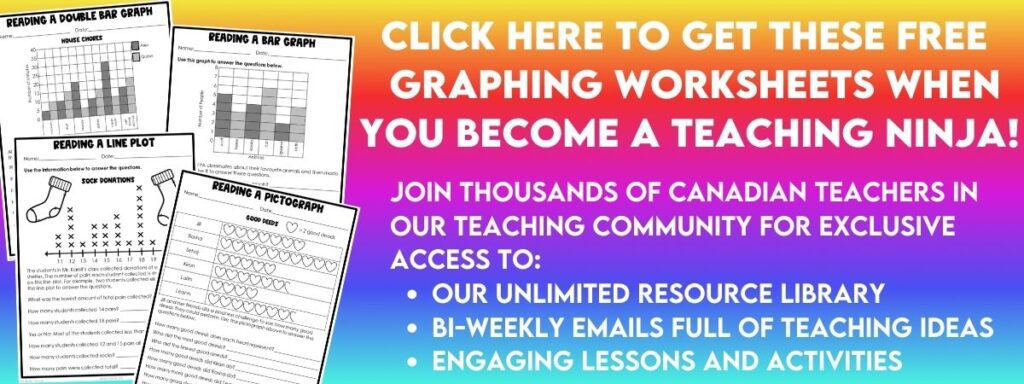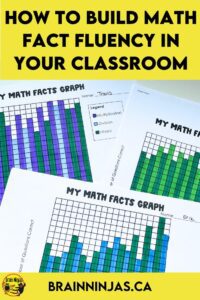
With so many things to do in math class each day, it’s almost impossible to help our students build fluency in math facts because there simply isn’t enough time. Timed drills have been proven to be unsuccessful for the majority of students because rather than testing mathematical knowledge, they test how fast a student thinks or writes. So, we were looking for a way to help students practice their math fact fluency without time constraints. That’s how we came up with our math fact fluency graphs.
Why Do We Practice Math Fact Fluency?
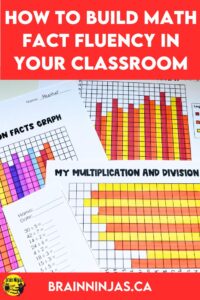
If students can’t recall their basic multiplication and division facts, it makes teaching long multiplication and long division very difficult. By practicing facts for east recall, students can focus on the steps for computation rather than the calculation. But, students just don’t have the memorization skills they used to. This means we need to help students learn how to recall their facts without rote memorization by building their math fact fluency. When faced with this, we looked for ways to build this into our math programming.
Each of our math lessons either begins or ends with a math fact fluency test. If math is right after a break, we’ll place the tests on students’ desks so they can complete them as they come in. This also speeds up the transition because students get right to work. If we do it at the end of the lesson, we hand out the tests as students are finishing their other work, but still have their books on their desks. Students who are early finishers are great at handing out resources to save you time.
This post outlines how to use our specific Math Facts Fluency Graphs (listed at the bottom), but you could make your own with any set of questions and some graph paper. We’ve just put it together to save you time. Our version just requires printing and using (though it does come with a digital version as well).
Prepare the Test and the Graphs
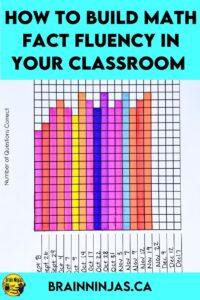
If you are printing the class set, there are four copies of the same test per page. This means you just need enough copies of that page to make a class set. So, if you have 25 students, you can print seven copies of the page and have a few left over. Print the pages and then cut them down the lines making a strip with 20 equations. Keep each set clipped together until you’re ready to use it. The order of the sets does not matter (except for having an answer key ready if you need it).
If you are using the version for individual students, print as many copies as you have students. When you cut the page apart, you’ll have four different tests. This is easier if you clip the sets together as you go so you don’t mix them up. In this case, you’re probably printing for less than ten students, so it doesn’t take too long to sort them out if needed.
You will need one blank graph per student. The type of graph you choose will depend on the type of tests you want to use. Some allow for one operation (bar graph) and others allow for more than one operation (double bar graph or line graph). If your students aren’t ready for double bar graphs yet, use one for multiplication, one for division and one more mixed and make each a bar graph.
Start With a Baseline Test
We start our math facts with a baseline test. This is a timed 20-equation test to see what students know. It is the only time we time students. The timing is mostly to just see what students know and this is not used for a formal assessment. Instead, students use this as a baseline to get started.
The equations are usually multiplication or division, but we also have sets for addition and subtraction. We start easier and work our way up the numbers throughout the year. Yes, we practice our facts all year long.
While we don’t have the time to do timed drills daily, we’ve learned that these drills do nothing to help students with recall. Students who are good at memorization or rote learning tend to do well in timed drills. However, for students who don’t excel at timed drills, there is no point in doing them. Especially if they don’t help students with their math computations. The whole point of math facts recall is to help students with their calculations.
So, after this initial timed test, we mark the test. Students mark their own and put the total number correct on the top. We use a graph and graph the results with the number correct and the date. This is the baseline. For the rest of the year, students work toward beating this result.
Using the Test Weekly
We try to do one or two of the tests weekly. Some weeks we do more and others we do less. We print a class set of all the tests and keep them ready to go. This is a great activity when you have a few extra minutes. They can also be used as centres. We keep a few in our sub tub so that students can do one anytime.
We hand out a test to everyone. This is where the opportunity to differentiate comes in. You could give students the same test or change up the difficulty. Students start the test at the same time. We put a stopwatch up on our screen if students want to time themselves. When they finish answering all the questions, they look up and write down their time on the top of the test. Students can choose to keep this information to themselves or put it on their graph beside the date. Some students choose to work on speed, but we always encourage accuracy over speed.
We give all students about five minutes to work on their test. While the test isn’t timed, we don’t want to spend all day working on it.
Provide Supports
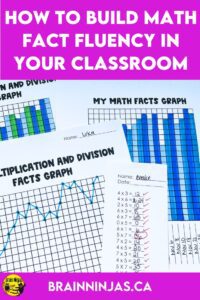
Some students are not ready to work through the equations without support. That’s ok. We start where they are and work toward improvement. For some students, this is a piece of scrap paper to make calculations. Others use manipulatives. We even allow students to use a multiplication chart. The point is recall and working toward independence. Students who regularly work through the same types of questions and feel supported without anxiety about being timed are more likely to learn the facts and not need as much support.
If your students need more help with multiplication or division, we have some blog posts that might help: Conquer Math With These Proven Multiplication Strategies or How to Teach Successful Long Division Strategies.
Ween Off the Supports
When students start getting the majority of the questions correct with support, start working toward independence from the support. For some students, this is as simple as working through all the questions they can do by memory before using the tools. For other students, this could be removing the supports altogether. Other students need to work through their incorrect answers.
Use Up the Extras
When you print a class set, there will always be a few extras. Let students take these to use for practicing on their own. If students are very eager to practice on their own, you can easily print extra copies. Even if students complete the same test over the year, they won’t be able to memorize the exact order of the answers. There’s no need to worry about duplicating the test. We even made a photocopying error one year and gave students the same test two times in a row that they didn’t even notice.
Mark the Test
As these tests are not being used for formal assessment, we let students mark their own using the honour system.
When we are doing the same test, we complete the answers with the class using a document camera. Students can lead this activity, too. One year students took turns completing the test with the class by reading the equation and the answer. Students made it more interesting by adding different accents, using silly voices or speaking in other languages.
If students are using different tests, they can mark in smaller groups or use the answer key. If we use the test in a centre, students learn to match the test number found on the bottom of the test with the answer key. However, if you are using different sets from our bundle, you will need to keep the different sets separated. For example, there is a Set 1 in the 5×5 set and a Set 1 in the 7×7 set.
Some students like to use an accountability partner. This works well for students who like to push themselves academically with a bit of competition. This small group of students could do a test together and then mark each other’s. This only works if all the students in the group consent to sharing results.
Graph the Results
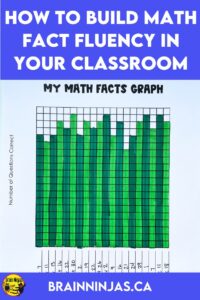
Each test has twenty questions, making graphing the results simple.
Most groups of our students make a bar graph or double bar graph as these are the most straightforward for the time of data being collected. Once you’ve taught students how to make line graphs, they could also make this type of graph.
Our sets come set up for students to add the date, the number of questions and in some cases a colour legend. This makes the graphing pretty simple for the majority of students.
Students graph their results. We ask students to prove their test matches their graph. The emphasis is not on the test result, but on graphing it correctly.
Look for Progress
As students graph more and more of their results, they might see a pattern emerge. Hopefully, that pattern shows improvement.
When students are regularly getting all the questions correct, they could be given more difficult questions, less support or less time to complete the test. If changes have been made, be sure to have students mark this on their graph too.
If your students need a quick refresher on graphing, use our free graphing worksheets. They can be found in our Resource Library for our ninjas on our email list. We can send it directly to your inbox when you sign up for our email list.
Where to Find Our Math Fact Fluency Graphs
(5 x 5 = 25) Multiplication & Division Find this set in our TpT Store ($USD) or BN Shop ($CAN).
(7 x 7 = 49) Multiplication & Division Find this set in our TpT Store ($USD) or BN Shop ($CAN).
(9 x 9 = 81) Multiplication & Division Find this set in our TpT Store ($USD) or BN Shop ($CAN).
(10 x 10 = 100) Multiplication & Division Find this set in our TpT Store ($USD) or BN Shop ($CAN).
(12 x 12) Multiplication & Division Find this set in our TpT Store ($USD) or BN Shop ($CAN).
The bundle with all five sets can be found in our TpT Store ($USD) or BN Shop ($CAN).
Need More Help Teaching Math?
Math Worksheet Games Your Students Will Love
How to Teach Students to Analyze Errors in Math
Ways to Bring Graphing Activities into Your Classroom Daily

